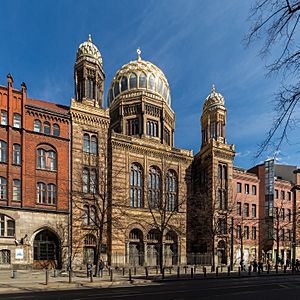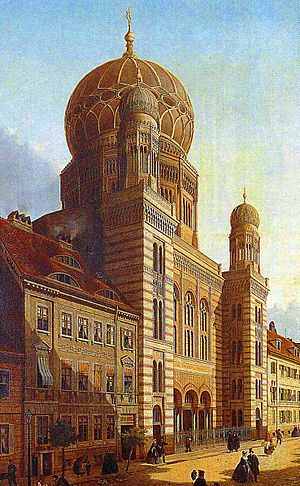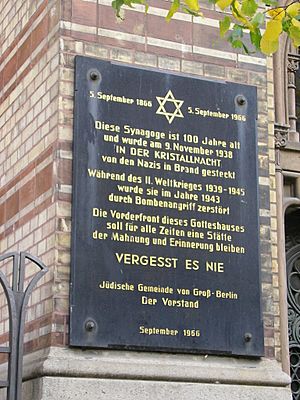New Synagogue (Berlin) facts for kids
Quick facts for kids Neue Synagoge |
|
|---|---|

The Neue Synagoge on Oranienburger Straße, Berlin-Mitte
|
|
| Religion | |
| Affiliation | Conservative Judaism |
| Rite | Ashkenaz |
| Leadership | Gesa Ederberg |
| Year consecrated | 1866 |
| Status | Active |
| Location | |
| Location | Oranienburger Straße 29–31, Berlin, Germany |
| Architecture | |
| Architectural type | Synagogue |
| Architectural style | Moorish Revival |
| Groundbreaking | 1859 |
| Completed | 1866 |
| Specifications | |
| Capacity | 3200 seats |
| Dome(s) | 3 |
The New Synagogue (German: Neue Synagoge) on Oranienburger Straße in Berlin is a very old and important Jewish place of worship. It was built in the mid-1800s for Berlin's growing Jewish community. Before this, the community used the Old Synagogue, but it became too small.
The New Synagogue looks special because of its eastern Moorish style. This style makes it look a bit like the famous Alhambra palace. This unique look makes it a very important building in Germany.
The building was designed by Eduard Knoblauch. After he passed away in 1865, Friedrich August Stüler finished most of the building. He also designed the inside. The synagogue officially opened in 1866. A very important person named Count Otto von Bismarck, who was like the prime minister of Prussia at the time, was there.
The New Synagogue was one of the few synagogues that survived the terrible event called Kristallnacht. However, it was badly damaged during and before World War II. Much of it was later torn down. Today, the building you see is a rebuilt part of the front, with its entrance, dome, and towers. Only a few rooms behind the front are left. The main prayer hall, which was very large, is no longer there.
A Look at the Building
The front of the synagogue, which faces Oranienburger Straße, is made of colorful bricks. It has many beautiful decorations made from sculpted bricks and terracotta. There are also shiny, colored glazed bricks that add to its beauty.
The building has a large central dome with golden ribs. This dome is very easy to spot and stands out in the city. On each side of the main dome, there are two smaller domes. Behind the entrance, there used to be a large hall and the main prayer area. This main hall could seat 3,000 people!
The New Synagogue is also special because it was one of the first buildings to use iron in its construction. You could see the iron in the outside columns. Iron was also used to build the dome and the floor of the main hall, which is now gone.
The Synagogue's History
The New Synagogue was built for the many Jewish people living in Berlin, especially those who had moved there from Eastern Europe. When it was built, it was the largest synagogue in Germany. It could hold 3,000 people for services and events.
The synagogue was also a place for public concerts. Famous people performed there, like Albert Einstein, who played the violin in 1930. The religious services here were modern for their time, with an organ and a choir. This showed how the Jewish community was changing.
One special concert was a Sabbath Evening Service. It was composed by Jacob Weinberg and led by Chemjo Winawer. This concert happened on October 25, 1936, and the synagogue was completely full. Everyone loved the music! Winawer and Weinberg worked together again in 1938. They performed Weinberg's opera "The Pioneers of Palestine" at another synagogue in Berlin. This was part of the Kulturbund, a program that allowed Jewish artists to perform their works during the Nazi era. Jewish people were not allowed to perform in regular concert halls, so synagogues became important places for these events.
During the November Pogrom on November 9, 1938, a Nazi mob attacked the New Synagogue. They broke in, damaged holy scrolls, smashed furniture, and tried to set the building on fire. However, a brave police officer named Lieutenant Otto Bellgardt arrived. He ordered the attackers to leave. He said the building was a protected historical landmark and even pulled out his pistol to show he would protect it. Because of him, the fire department could come and put out the fire before it destroyed the building. The synagogue was saved!
The New Synagogue was repaired and continued to be used by the Jewish community until 1940. Besides prayers, the main hall was used for concerts and talks. This was important because Jewish people were not allowed in other public places. The last concert in the main hall was on March 31, 1940. It was a charity concert to help poor Jewish people.
Soon after, the main hall was taken over by the German Army. They used it to store uniforms. The Jewish community still used the office rooms in the front part of the synagogue for a while. They even held prayers in one of these rooms until 1942.
During World War II, the New Synagogue was badly damaged by bombs. It was completely burned during British air raids on Berlin in November 1943.
After the war, in 1946, the Jewish community in Berlin started meeting again in a building next to the synagogue that had survived. In 1958, the ruined back parts of the synagogue, including the main prayer hall, were torn down. The damaged central dome was also removed. The Jewish community in East Berlin was very small and poor after the Holocaust, so they could not afford to rebuild it.
It was not until after the Berlin Wall fell in 1989 that rebuilding began. From 1988 to 1993, the front part of the building was restored. This included the beautiful front, the dome, and some rooms behind it. This restored part is now called the "Centrum Judaicum" (Jewish Center). The main prayer hall was not rebuilt.
In May 1995, a small synagogue congregation started meeting again in one of the restored rooms. The area where the main prayer hall used to be is now an empty space. Visitors can walk through it.
The rebuilding of the New Synagogue helped the whole neighborhood around it, called Spandauer Vorstadt, come back to life. Many nice restaurants and shops opened there.
In 2007, Gesa Ederberg became the first female rabbi at the New Synagogue.
The Synagogue Today
Today, Jewish services are held again in the New Synagogue. It is the only Masorti synagogue in Berlin. Most of the building is used for offices and a museum. You can also visit the dome.
See also
 In Spanish: Nueva Synagoga (Berlín) para niños
In Spanish: Nueva Synagoga (Berlín) para niños
- Religion in Berlin
- Fasanenstrasse Synagogue
- Louis Lewandowski – A choirmaster and composer who worked at the New Synagogue.




